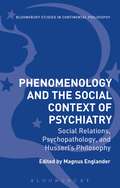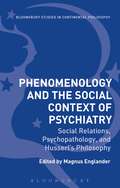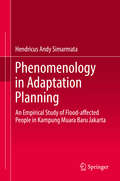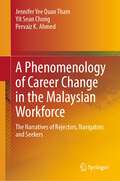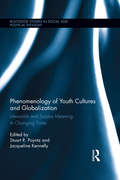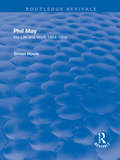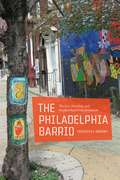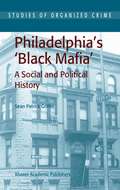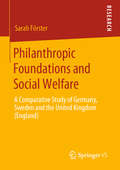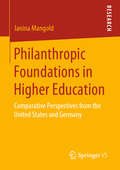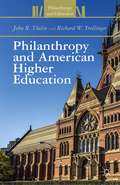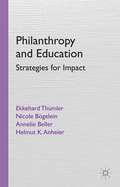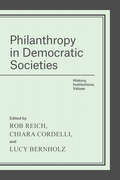- Table View
- List View
Phenomenology and the Social Context of Psychiatry: Social Relations, Psychopathology, and Husserl's Philosophy (Bloomsbury Studies in Continental Philosophy)
by Magnus EnglanderExploring phenomenological philosophy as it relates to psychiatry and the social world, this book establishes a common language between psychiatrists, anti-psychiatrists, psychologists and social workers. Phenomenology and the Social Context of Psychiatry is an inter-disciplinary work by phenomenological philosophers, psychiatrists, and psychologists to discover the essence and foundations of social psychiatry. Using the phenomenology of Husserl as a point of departure, the meanings of empathy, interpersonal understanding, we-intentionality, ethics, citizenship and social inclusion are investigated in relation to psychopathology, nosology, and clinical research. This work, drawing upon the rich classical and contemporary phenomenological tradition, touching on a broad range of thinkers such as Deleuze, Levinas, and R.D. Laing, also explicates how phenomenology is a method capable of capturing the human condition and its intricate relation to the social world and mental illness
Phenomenology and the Social Context of Psychiatry: Social Relations, Psychopathology, and Husserl's Philosophy (Bloomsbury Studies in Continental Philosophy)
by Magnus EnglanderExploring phenomenological philosophy as it relates to psychiatry and the social world, this book establishes a common language between psychiatrists, anti-psychiatrists, psychologists and social workers. Phenomenology and the Social Context of Psychiatry is an inter-disciplinary work by phenomenological philosophers, psychiatrists, and psychologists to discover the essence and foundations of social psychiatry. Using the phenomenology of Husserl as a point of departure, the meanings of empathy, interpersonal understanding, we-intentionality, ethics, citizenship and social inclusion are investigated in relation to psychopathology, nosology, and clinical research. This work, drawing upon the rich classical and contemporary phenomenological tradition, touching on a broad range of thinkers such as Deleuze, Levinas, and R.D. Laing, also explicates how phenomenology is a method capable of capturing the human condition and its intricate relation to the social world and mental illness
Phenomenology in Adaptation Planning: An Empirical Study of Flood-affected People in Kampung Muara Baru Jakarta
by Hendricus Andy SimarmataThis book explores the planning knowledge that can be gleaned from the experiences of the urban poor, a group frequently affected by floods. Further, it examines the relationship between lifeworld analysis and adaptation planning through the sociology of knowledge, which plays a significant part in determining the adaptation pathway of the urban poor. The book brings together empirical data to translate self-reflective planning theory into the practical context, examines community planning, and enriches the discourse on urban adaptation. Lastly, it provides an adaptation-planning model that can benefit academics, practitioners and policymakers who wish to provide more socially accepted plans.
A Phenomenology of Career Change in the Malaysian Workforce: The Narratives of Rejectors, Navigators and Seekers
by Jennifer Yee Tham Yit Sean Chong Pervaiz K. AhmedEvolution in economy, technology and social institutions over time have given rise to boundaryless and Protean careers that promote mobility and self-direction in managing one’s career. This has led to the phenomenon of career change whereby individuals undertake a shift from one field of work to a completely different field of work. In career change research, career changers have been studied as a collective, singular group undergoing a similar change experience, which neglects individual differences that may contrast the experience of change from one changer to another. Furthermore, the emotional experience that accompanies a career change has been examined with a primary focus on the role of positive emotions, which overlooks the role of negative emotions in career change. Thus, this book sheds light on three key narratives of career change; Rejectors, Navigators and Seekers, that were identified in a phenomenological study of career change amongst Malaysian working adults. Semi-structured interviews were conducted with 30 career changers across age, gender and ethnicity with a focus on how they made sense and meaning of their lived experience of career change within their environment and context. Each career change narrative was found to have different characteristics, motivations and behaviors respectively, which shaped their unique career change process. Negative emotions were also revealed as key drivers of the career change process, although each narrative expressed different types of negative emotions.Finally, the book also introduces an adaptive perspective to career development by way of the Adaptive Career Construal Model (ACCM) which was proposed based on the continuous bi-directional relationship between career decisions and career outcomes.
Phenomenology of Youth Cultures and Globalization: Lifeworlds and Surplus Meaning in Changing Times (Routledge Studies in Social and Political Thought)
by Stuart R. Poyntz Jacqueline KennellyThis edited collection brings together scholars who draw on phenomenological approaches to understand the experiences of young people growing up under contemporary conditions of globalization. Phenomenology is both a philosophical and pragmatic approach to social sciences research, that takes as central the meaning-making experiences of research participants. One of the central contentions of this book is that phenomenology has long informed critical empirical approaches to youth cultures, yet until recently its role has not been thusly named. This volume aims to resuscitate and recuperate phenomenology as a robust empirical, theoretical, and methodological approach to youth cultures. Chapters explore the lifeworlds of young people from countries around the world, revealing the tensions, risks and opportunities that organize youth experiences.
Phenomenology of Youth Cultures and Globalization: Lifeworlds and Surplus Meaning in Changing Times (Routledge Studies in Social and Political Thought #99)
by Stuart R. Poyntz Jacqueline KennellyThis edited collection brings together scholars who draw on phenomenological approaches to understand the experiences of young people growing up under contemporary conditions of globalization. Phenomenology is both a philosophical and pragmatic approach to social sciences research, that takes as central the meaning-making experiences of research participants. One of the central contentions of this book is that phenomenology has long informed critical empirical approaches to youth cultures, yet until recently its role has not been thusly named. This volume aims to resuscitate and recuperate phenomenology as a robust empirical, theoretical, and methodological approach to youth cultures. Chapters explore the lifeworlds of young people from countries around the world, revealing the tensions, risks and opportunities that organize youth experiences.
Phil May: His Life and Work 1864-1903 (Routledge Revivals)
by Simon HoufeThis title was first published in 2002: Phil May (1864-1903) was one of the two outstanding British black and white artists of the 1890s - the other was Aubrey Beardsley. The work of both artists displays a masterly use of line to create character, but rather than focusing on subjects drawn from polite English society, May's world is that of ordinary people at the public house, the club, the race-course, the theatre and the East End. May spent some years in Australia before returning to achieve general acclaim as a foremost illustrator. He contributed humorous pen-and-ink drawings to popularist publications such as "The Daily Graphic" and "Punch", and became highly regarded by fellow artists James McNeill Whistler and Joseph Pennell. In this book, Simon Houfe offers insights into the interface between the artist's life and work, bringing into view an innovative figure working at the height of one of the most dazzling periods for black and white art.
Phil May: His Life and Work 1864-1903 (Routledge Revivals)
by Simon HoufeThis title was first published in 2002: Phil May (1864-1903) was one of the two outstanding British black and white artists of the 1890s - the other was Aubrey Beardsley. The work of both artists displays a masterly use of line to create character, but rather than focusing on subjects drawn from polite English society, May's world is that of ordinary people at the public house, the club, the race-course, the theatre and the East End. May spent some years in Australia before returning to achieve general acclaim as a foremost illustrator. He contributed humorous pen-and-ink drawings to popularist publications such as "The Daily Graphic" and "Punch", and became highly regarded by fellow artists James McNeill Whistler and Joseph Pennell. In this book, Simon Houfe offers insights into the interface between the artist's life and work, bringing into view an innovative figure working at the height of one of the most dazzling periods for black and white art.
The Philadelphia Barrio: The Arts, Branding, and Neighborhood Transformation
by Frederick F. WherryHow does a so-called bad neighborhood go about changing its reputation? Is it simply a matter of improving material conditions or picking the savviest marketing strategy? What kind of role can or should the arts play in that process? Does gentrification always entail a betrayal of a neighborhood’s roots? Tackling these questions and offering a fresh take on the dynamics of urban revitalization, The Philadelphia Barrio examines one neighborhood’s fight to erase the stigma of devastation. Frederick F. Wherry shows how, in the predominantly Latino neighborhood of Centro de Oro, entrepreneurs and community leaders forged connections between local businesses and cultural institutions to rebrand a place once nicknamed the Badlands. Artists and performers negotiated with government organizations and national foundations, Wherry reveals, and took to local galleries, stages, storefronts, and street parades in a concerted, canny effort to reanimate the spirit of their neighborhood. Complicating our notions of neighborhood change by exploring the ways the process is driven by local residents, The Philadelphia Barrio presents a nuanced look at how city dwellers can make commercial interests serve the local culture, rather than exploit it.
The Philadelphia Barrio: The Arts, Branding, and Neighborhood Transformation
by Frederick F. WherryHow does a so-called bad neighborhood go about changing its reputation? Is it simply a matter of improving material conditions or picking the savviest marketing strategy? What kind of role can or should the arts play in that process? Does gentrification always entail a betrayal of a neighborhood’s roots? Tackling these questions and offering a fresh take on the dynamics of urban revitalization, The Philadelphia Barrio examines one neighborhood’s fight to erase the stigma of devastation. Frederick F. Wherry shows how, in the predominantly Latino neighborhood of Centro de Oro, entrepreneurs and community leaders forged connections between local businesses and cultural institutions to rebrand a place once nicknamed the Badlands. Artists and performers negotiated with government organizations and national foundations, Wherry reveals, and took to local galleries, stages, storefronts, and street parades in a concerted, canny effort to reanimate the spirit of their neighborhood. Complicating our notions of neighborhood change by exploring the ways the process is driven by local residents, The Philadelphia Barrio presents a nuanced look at how city dwellers can make commercial interests serve the local culture, rather than exploit it.
The Philadelphia Barrio: The Arts, Branding, and Neighborhood Transformation
by Frederick F. WherryHow does a so-called bad neighborhood go about changing its reputation? Is it simply a matter of improving material conditions or picking the savviest marketing strategy? What kind of role can or should the arts play in that process? Does gentrification always entail a betrayal of a neighborhood’s roots? Tackling these questions and offering a fresh take on the dynamics of urban revitalization, The Philadelphia Barrio examines one neighborhood’s fight to erase the stigma of devastation. Frederick F. Wherry shows how, in the predominantly Latino neighborhood of Centro de Oro, entrepreneurs and community leaders forged connections between local businesses and cultural institutions to rebrand a place once nicknamed the Badlands. Artists and performers negotiated with government organizations and national foundations, Wherry reveals, and took to local galleries, stages, storefronts, and street parades in a concerted, canny effort to reanimate the spirit of their neighborhood. Complicating our notions of neighborhood change by exploring the ways the process is driven by local residents, The Philadelphia Barrio presents a nuanced look at how city dwellers can make commercial interests serve the local culture, rather than exploit it.
The Philadelphia Barrio: The Arts, Branding, and Neighborhood Transformation
by Frederick F. WherryHow does a so-called bad neighborhood go about changing its reputation? Is it simply a matter of improving material conditions or picking the savviest marketing strategy? What kind of role can or should the arts play in that process? Does gentrification always entail a betrayal of a neighborhood’s roots? Tackling these questions and offering a fresh take on the dynamics of urban revitalization, The Philadelphia Barrio examines one neighborhood’s fight to erase the stigma of devastation. Frederick F. Wherry shows how, in the predominantly Latino neighborhood of Centro de Oro, entrepreneurs and community leaders forged connections between local businesses and cultural institutions to rebrand a place once nicknamed the Badlands. Artists and performers negotiated with government organizations and national foundations, Wherry reveals, and took to local galleries, stages, storefronts, and street parades in a concerted, canny effort to reanimate the spirit of their neighborhood. Complicating our notions of neighborhood change by exploring the ways the process is driven by local residents, The Philadelphia Barrio presents a nuanced look at how city dwellers can make commercial interests serve the local culture, rather than exploit it.
The Philadelphia Barrio: The Arts, Branding, and Neighborhood Transformation
by Frederick F. WherryHow does a so-called bad neighborhood go about changing its reputation? Is it simply a matter of improving material conditions or picking the savviest marketing strategy? What kind of role can or should the arts play in that process? Does gentrification always entail a betrayal of a neighborhood’s roots? Tackling these questions and offering a fresh take on the dynamics of urban revitalization, The Philadelphia Barrio examines one neighborhood’s fight to erase the stigma of devastation. Frederick F. Wherry shows how, in the predominantly Latino neighborhood of Centro de Oro, entrepreneurs and community leaders forged connections between local businesses and cultural institutions to rebrand a place once nicknamed the Badlands. Artists and performers negotiated with government organizations and national foundations, Wherry reveals, and took to local galleries, stages, storefronts, and street parades in a concerted, canny effort to reanimate the spirit of their neighborhood. Complicating our notions of neighborhood change by exploring the ways the process is driven by local residents, The Philadelphia Barrio presents a nuanced look at how city dwellers can make commercial interests serve the local culture, rather than exploit it.
The Philadelphia Barrio: The Arts, Branding, and Neighborhood Transformation
by Frederick F. WherryHow does a so-called bad neighborhood go about changing its reputation? Is it simply a matter of improving material conditions or picking the savviest marketing strategy? What kind of role can or should the arts play in that process? Does gentrification always entail a betrayal of a neighborhood’s roots? Tackling these questions and offering a fresh take on the dynamics of urban revitalization, The Philadelphia Barrio examines one neighborhood’s fight to erase the stigma of devastation. Frederick F. Wherry shows how, in the predominantly Latino neighborhood of Centro de Oro, entrepreneurs and community leaders forged connections between local businesses and cultural institutions to rebrand a place once nicknamed the Badlands. Artists and performers negotiated with government organizations and national foundations, Wherry reveals, and took to local galleries, stages, storefronts, and street parades in a concerted, canny effort to reanimate the spirit of their neighborhood. Complicating our notions of neighborhood change by exploring the ways the process is driven by local residents, The Philadelphia Barrio presents a nuanced look at how city dwellers can make commercial interests serve the local culture, rather than exploit it.
Philadelphia's Black Mafia: A Social and Political History (Studies of Organized Crime #2)
by S.P. GriffinPhiladelphia's 'Black Mafia' could be used as primary reading in deviance and organized crime courses. Academicians in the fields of criminology, sociology, history, political science and African-American Studies will find the book compelling and important. This book provides the first sociological analysis to date of Philadelphia's infamous "Black Mafia" which has organized crime (with varying degrees of success) in predominantly African-American sections of the city dating back to the late 1960's. Philadelphia's 'Black Mafia': -is a first step in developing both data and sophisticated theoretical propositions germane to the ongoing study of organized crime; -uses primary source documents, including confidential law enforcement files, court transcripts and interviews; -explores the group's activities in detail, depicting some of the most notorious crimes in Philadelphia's history; -thoroughly examines the organization of the Black Mafia and the group's alliances, conspiracies and conflicts; -challenges many of the current historical and theoretical assumptions regarding organized crime.
Philanthropic Foundations and Social Welfare: A Comparative Study of Germany, Sweden and the United Kingdom (England)
by Sarah FörsterThe existing welfare regime literature identifies differences in welfare state systems. Sarah Förster asks, if we can learn something on the organizational level about the embedding of philanthropic foundations in the field of social welfare in different welfare state systems. This investigation is based on comparative insights from the three country cases of Germany, Sweden and the UK (England). Guided by propositions from theoretical analysis of welfare regime literature, comparative explorative case studies based on interview data and secondary sources give insights into the field and the embedding of philanthropic social welfare foundations in the three different welfare state systems. Each type of foundation has different levels of independence from external constraints and is embedded to different degrees according to the propositions from welfare regime theory. These differences hold further implications for the investigation of foundations as a special organizational form.
Philanthropic Foundations in Higher Education: Comparative Perspectives from the United States and Germany
by Janina MangoldJanina Mangold uncovers the contributions of philanthropic foundations in higher education in Germany and the USA. Considering the three regime classifications of Varieties of Capitalism, Three Worlds of Welfare Capitalism, and Social Origins Theory, she examines the role and positioning of German and American higher education foundations vis-à-vis state and market actors in contemporary society. On the basis of both qualitative and quantitative data, she then develops urgent policy recommendations for foundations, higher education, and governments.
Philanthropy and American Higher Education (Philanthropy and Education)
by J. Thelin R. TrollingerPhilanthropy and American Higher Education provides higher education professionals, leaders and scholars with a thoughtful, comprehensive introduction to the scope and development of philanthropy and fund raising as part of the essential life and work of colleges and universities in the United States.
Philanthropy and Education: Strategies for Impact
by E. Thümler N. Bögelein A. Beller H. AnheierPhilanthropic foundations play an increasingly important role in attempts to enhance the performance of school systems. Based on case studies from Germany, Switzerland and the US, this book develops an innovative model of effective education philanthropy for successfully tackling problems in the complex field of education.
Philanthropy in Democratic Societies: History, Institutions, Values
by Rob Reich Chiara Cordelli Lucy BernholzPhilanthropy is everywhere. In 2013, in the United States alone, some $330 billion was recorded in giving, from large donations by the wealthy all the way down to informal giving circles. We tend to think of philanthropy as unequivocally good, but as the contributors to this book show, philanthropy is also an exercise of power. And like all forms of power, especially in a democratic society, it deserves scrutiny. Yet it rarely has been given serious attention. This book fills that gap, bringing together expert philosophers, sociologists, political scientists, historians, and legal scholars to ask fundamental and pressing questions about philanthropy’s role in democratic societies. The contributors balance empirical and normative approaches, exploring both the roles philanthropy has actually played in societies and the roles it should play. They ask a multitude of questions: When is philanthropy good or bad for democracy? How does, and should, philanthropic power interact with expectations of equal citizenship and democratic political voice? What makes the exercise of philanthropic power legitimate? What forms of private activity in the public interest should democracy promote, and what forms should it resist? Examining these and many other topics, the contributors offer a vital assessment of philanthropy at a time when its power to affect public outcomes has never been greater.
Philanthropy in Democratic Societies: History, Institutions, Values
by Rob Reich Chiara Cordelli Lucy BernholzPhilanthropy is everywhere. In 2013, in the United States alone, some $330 billion was recorded in giving, from large donations by the wealthy all the way down to informal giving circles. We tend to think of philanthropy as unequivocally good, but as the contributors to this book show, philanthropy is also an exercise of power. And like all forms of power, especially in a democratic society, it deserves scrutiny. Yet it rarely has been given serious attention. This book fills that gap, bringing together expert philosophers, sociologists, political scientists, historians, and legal scholars to ask fundamental and pressing questions about philanthropy’s role in democratic societies. The contributors balance empirical and normative approaches, exploring both the roles philanthropy has actually played in societies and the roles it should play. They ask a multitude of questions: When is philanthropy good or bad for democracy? How does, and should, philanthropic power interact with expectations of equal citizenship and democratic political voice? What makes the exercise of philanthropic power legitimate? What forms of private activity in the public interest should democracy promote, and what forms should it resist? Examining these and many other topics, the contributors offer a vital assessment of philanthropy at a time when its power to affect public outcomes has never been greater.
Philanthropy in Democratic Societies: History, Institutions, Values
by Rob Reich, Chiara Cordelli, and Lucy Bernholz Chiara Cordelli Lucy BernholzPhilanthropy is everywhere. In 2013, in the United States alone, some $330 billion was recorded in giving, from large donations by the wealthy all the way down to informal giving circles. We tend to think of philanthropy as unequivocally good, but as the contributors to this book show, philanthropy is also an exercise of power. And like all forms of power, especially in a democratic society, it deserves scrutiny. Yet it rarely has been given serious attention. This book fills that gap, bringing together expert philosophers, sociologists, political scientists, historians, and legal scholars to ask fundamental and pressing questions about philanthropy’s role in democratic societies. The contributors balance empirical and normative approaches, exploring both the roles philanthropy has actually played in societies and the roles it should play. They ask a multitude of questions: When is philanthropy good or bad for democracy? How does, and should, philanthropic power interact with expectations of equal citizenship and democratic political voice? What makes the exercise of philanthropic power legitimate? What forms of private activity in the public interest should democracy promote, and what forms should it resist? Examining these and many other topics, the contributors offer a vital assessment of philanthropy at a time when its power to affect public outcomes has never been greater.
Philanthropy in Democratic Societies: History, Institutions, Values
by Rob Reich, Chiara Cordelli, and Lucy Bernholz Chiara Cordelli Lucy BernholzPhilanthropy is everywhere. In 2013, in the United States alone, some $330 billion was recorded in giving, from large donations by the wealthy all the way down to informal giving circles. We tend to think of philanthropy as unequivocally good, but as the contributors to this book show, philanthropy is also an exercise of power. And like all forms of power, especially in a democratic society, it deserves scrutiny. Yet it rarely has been given serious attention. This book fills that gap, bringing together expert philosophers, sociologists, political scientists, historians, and legal scholars to ask fundamental and pressing questions about philanthropy’s role in democratic societies. The contributors balance empirical and normative approaches, exploring both the roles philanthropy has actually played in societies and the roles it should play. They ask a multitude of questions: When is philanthropy good or bad for democracy? How does, and should, philanthropic power interact with expectations of equal citizenship and democratic political voice? What makes the exercise of philanthropic power legitimate? What forms of private activity in the public interest should democracy promote, and what forms should it resist? Examining these and many other topics, the contributors offer a vital assessment of philanthropy at a time when its power to affect public outcomes has never been greater.
Philanthropy in Democratic Societies: History, Institutions, Values
by Rob Reich, Chiara Cordelli, and Lucy Bernholz Chiara Cordelli Lucy BernholzPhilanthropy is everywhere. In 2013, in the United States alone, some $330 billion was recorded in giving, from large donations by the wealthy all the way down to informal giving circles. We tend to think of philanthropy as unequivocally good, but as the contributors to this book show, philanthropy is also an exercise of power. And like all forms of power, especially in a democratic society, it deserves scrutiny. Yet it rarely has been given serious attention. This book fills that gap, bringing together expert philosophers, sociologists, political scientists, historians, and legal scholars to ask fundamental and pressing questions about philanthropy’s role in democratic societies. The contributors balance empirical and normative approaches, exploring both the roles philanthropy has actually played in societies and the roles it should play. They ask a multitude of questions: When is philanthropy good or bad for democracy? How does, and should, philanthropic power interact with expectations of equal citizenship and democratic political voice? What makes the exercise of philanthropic power legitimate? What forms of private activity in the public interest should democracy promote, and what forms should it resist? Examining these and many other topics, the contributors offer a vital assessment of philanthropy at a time when its power to affect public outcomes has never been greater.
Philanthropy in Democratic Societies: History, Institutions, Values
Philanthropy is everywhere. In 2013, in the United States alone, some $330 billion was recorded in giving, from large donations by the wealthy all the way down to informal giving circles. We tend to think of philanthropy as unequivocally good, but as the contributors to this book show, philanthropy is also an exercise of power. And like all forms of power, especially in a democratic society, it deserves scrutiny. Yet it rarely has been given serious attention. This book fills that gap, bringing together expert philosophers, sociologists, political scientists, historians, and legal scholars to ask fundamental and pressing questions about philanthropy’s role in democratic societies. The contributors balance empirical and normative approaches, exploring both the roles philanthropy has actually played in societies and the roles it should play. They ask a multitude of questions: When is philanthropy good or bad for democracy? How does, and should, philanthropic power interact with expectations of equal citizenship and democratic political voice? What makes the exercise of philanthropic power legitimate? What forms of private activity in the public interest should democracy promote, and what forms should it resist? Examining these and many other topics, the contributors offer a vital assessment of philanthropy at a time when its power to affect public outcomes has never been greater.
